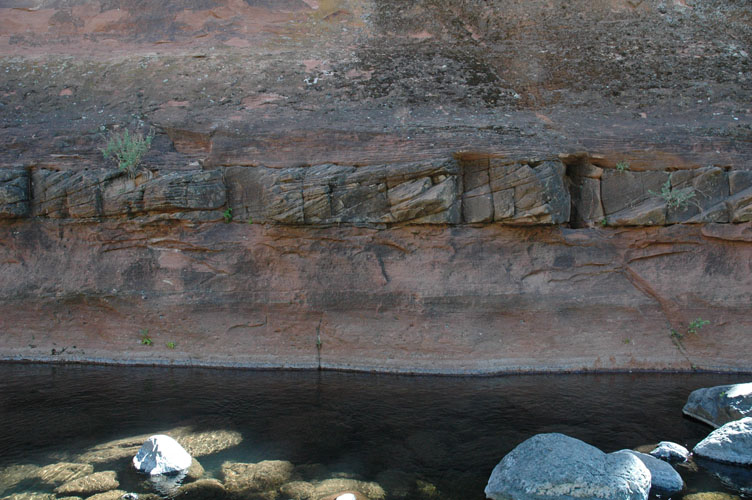The late Paleozoic sedimentary rocks comprise two
formations from the Pennsylvanian through Permian Periods of
the Paleozoic Era . These Pennsylvanian-Permian
formations vary in composition and origin and are part of the regional aquifer. They
are, from youngest to oldest:
Permian Coconino Sandstone (~ 265 million years
old): The
Coconino is a massive, very fine- to fine-grained cross-bedded
sandstone unit that is fairly homogeneous in composition. Unlike
the other Paleozoic units in the area, which are mostly
interpreted as being of marine origin, the Coconino has
been interpreted to be of aeolian origin, representing
a time when the sea bordering Permian Western North America was
in a regressive phase. Fracturing and jointing are common,
as well as parting along bedding planes, facilitating the
transmission of water through the unit. The
Coconino Sandstone crops out throughout most of Wet Beaver Creek Canyon and is the source of many springs throughout the watershed.

Crossbeds in Coconino Sandstone, Wet Beaver Creek
Pennsylvanian Naco Formation (~ 300 m.y.): The Naco Formation consists of a limy siltstone, a fine-grained sandstone interbedded with limestone, and a sandy shale and chert breccia layer at the base. Though this formation is not known to crop out in the Beaver Creek Watershed, it is part of the aquifer within the Mogollon Rim area.
Pennsylvanian-Permian Supai Formation (~ 275-320
m.y.): The
Supai is divided into several members, ranging in composition
from sandstone to siltstone, mudstone, conglomerate, and
limestone. The Supai crops out in the southernmost part of the watershed and is part of the regional aquifer.
Reference:
Owen-Joyce, S.J. and Bell, C.K., 1983 Appraisal of Water Resources in the Upper Verde River Area, Yavapai County, Arizona, Arizona Department of Water Resources Bulletin 2 (Prepared by the U.S. Geological Survey), available online at: http://www.verde.org/usgs/usgsstud.html.




